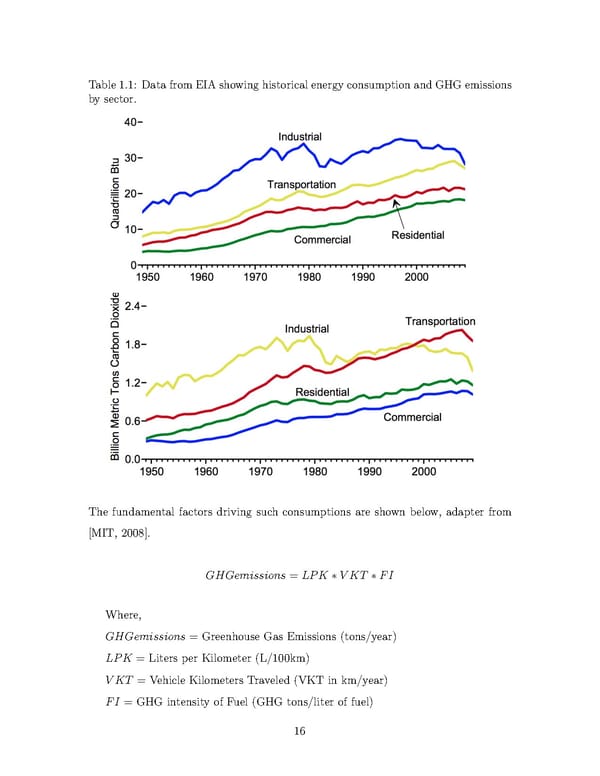Zoepf MS_Thesis
Automotive Features: Mass Impact and Deployment Characterization by Stephen M. Zoepf B.S. Electrical Engineering, Massachusetts Institute of Technology, 2001 Submitted to the Engineering Systems Division in partial fulfillment of the requirements for the degree of Master of Science in Technology and Policy at the MASSACHUSETTSINSTITUTEOFTECHNOLOGY June 2011 c Massachusetts Institute of Technology 2011. All rights reserved. Author.............................................................. Engineering Systems Division May 13, 2011 Certified by.......................................................... Professor John B. Heywood Professor of Mechanical Engineering Sun Jae Professor, Emeritus Thesis Supervisor Accepted by......................................................... Professor Dava J. Newman Professor of Aeronautics and Astronautics and Engineering Systems Director, Technology and Policy Program
Automotive Features: Mass Impact and Deployment Characterization by Stephen M. Zoepf Submitted to the Engineering Systems Division on May 13, 2011, in partial fulfillment of the requirements for the degree of Master of Science in Technology and Policy Abstract Passenger car use is a major driver of greenhouse gas (GHG) emissions and fossil fuel consumption in the United States. Vehicles continue to incorporate increasing levels of technology, these advances do not translate directly into improved fuel economy. Vehicle weight, interior volume and performance have all grown substantially in the past 30 years, as has feature content. This thesis shows that safety features, emissions controls, and optional equipment account for a total mass that mirrors growth in vehicle mass during this time pe- riod. Chief among these are optional features designed to improve the comfort and convenience of passenger cars. This thesis also examines historical deployment rates of vehicle features. Safety features and emissions controls achieve faster deployment rates than other optional features. While these features are those most governed by regulation, it is not clear that regulations push technology deployment rates higher. Automotive product de- velopment is complex and features require significant time to overcome deployment constraints. This lag time, from first production use to most rapid deployment across the vehicle fleet, is found to be exponentially decreasing for all feature types and has dropped to approximately a decade. These analyses provide two countering assessments. New vehicles will continue to grow heavier due to the continued incorporation of new features, but technology that may improve overall eciency can be brought to market ever faster. Thesis Supervisor: Professor John B. Heywood Title: Professor of Mechanical Engineering Sun Jae Professor, Emeritus 3
Acknowledgments This thesis would not have been possible without the help and support of many people from the MIT community and beyond. First and foremost I would like to o↵er my sincere thanks to Prof. John Heywood for his guidance and support these past two years as my advisor. I am humbled by his immense knowledge, talent and kindness. I would like to thank my fellow students from the Sloan Automotive Laboratory: DonMacKenzie,FernandodeSisternes,LynetteCheah,ValerieKarplus,DavidKeith, Irene Berry, Eriko Nishimura and Mike Khusid. My work has built upon much of their own and has been improved greatly by their feedback. Many thanks also to Prof. Randy Kirchain, Rich Roth and Elisa Alonso from the Materials Systems Laboratory for their contributions. Iwouldalsoliketothankthesta↵ of the U.S. Department of Transportation and the Volpe Center for their information and feedback. Thefaculty and sta↵ of the Engineering Systems Division and the Technology and Policy Program have been a great help at every step. It has been a pleasure to learn from their vast experience these past two years. Finally, I would like to thank my wife, Irma, for her unwavering support and encouragement. She is a pillar of strength and I am forever indebted for the sacrifices she has made in accompanying me to graduate school. This work has been sponsored by Ford Motor Company and the MIT Portugal Program. 5
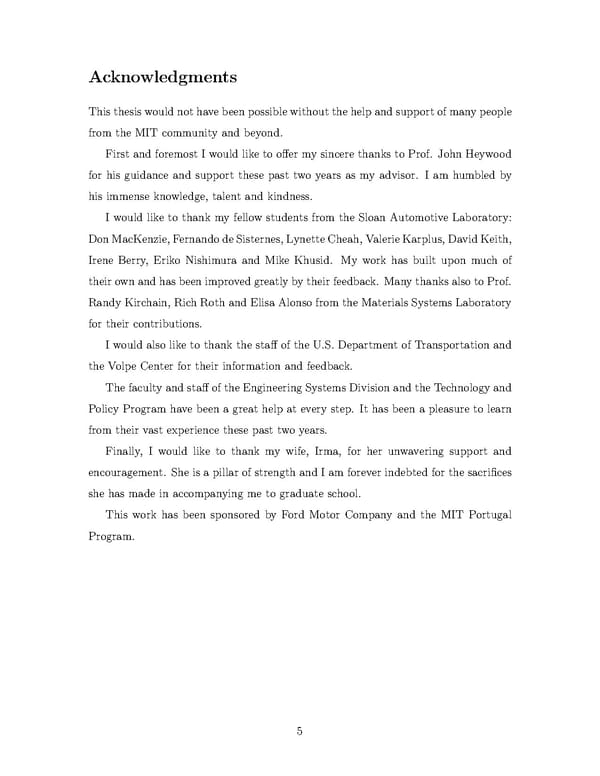
Contents 1 Introduction 15 1.1 Vehicle Evolution . . . . . . . . . . . . . . . . . . . . . . . . . . . . . 17 1.2 Motivation . . . . . . . . . . . . . . . . . . . . . . . . . . . . . . . . . 18 1.3 Research Objectives . . . . . . . . . . . . . . . . . . . . . . . . . . . . 19 1.4 Methodology and Comments . . . . . . . . . . . . . . . . . . . . . . . 21 1.4.1 Data Sources . . . . . . . . . . . . . . . . . . . . . . . . . . . 21 1.4.2 Limitations . . . . . . . . . . . . . . . . . . . . . . . . . . . . 22 2 Vehicle Features 25 2.1 Definitions . . . . . . . . . . . . . . . . . . . . . . . . . . . . . . . . . 25 2.2 Context . . . . . . . . . . . . . . . . . . . . . . . . . . . . . . . . . . 26 2.3 Safety Features . . . . . . . . . . . . . . . . . . . . . . . . . . . . . . 27 2.4 Emissions Controls . . . . . . . . . . . . . . . . . . . . . . . . . . . . 29 2.5 Optional Features . . . . . . . . . . . . . . . . . . . . . . . . . . . . . 32 2.6 Secondary Mass . . . . . . . . . . . . . . . . . . . . . . . . . . . . . . 34 2.7 Conclusions . . . . . . . . . . . . . . . . . . . . . . . . . . . . . . . . 36 3 Measuring Technological Sophistication 39 3.1 BMEP . . . . . . . . . . . . . . . . . . . . . . . . . . . . . . . . . . . 40 3.2 PSFI . . . . . . . . . . . . . . . . . . . . . . . . . . . . . . . . . . . . 40 3.3 Adjusted PSFI . . . . . . . . . . . . . . . . . . . . . . . . . . . . . . 42 3.4 Conclusions and Tradeo↵s........................ 43 7
Chapter 1 Introduction Chapter 1 Chapter 1 outlines the importance of transportation in petroleum and GHG contexts, discusses the importance of vehicle features in the evolution of the passenger car, and outlines the themes to be discussed in the remainder of the document. For nearly a century the automobile has been the dominant form of personal transportation in the United States. The passenger car has made inexpensive, reliable transportation accessible to virtually every citizen and has profoundly a↵ected the development of modern society. Atthesametime,transportationhasalsobecomeadominantsourceofgreenhouse gas (GHG) emissions and fossil fuel consumption in the United States. As shown in Table 1.1, the Transportation sector represents a growing driver of energy and fossil fuel use. The Transportation sector is now responsible for 71% of petroleum consumption and 34% of GHG emissions. Since 1999 the Transportation sector has exceeded the Industrial sector as the largest emitter of greenhouse gases.[EIA, 2010] The Transportation sector derives 94% of its energy from Petroleum. 45% of this petroleum is used to produce motor gasoline, the vast majority of which is used to fuel Light Duty Vehicles (LDVs). The GHG emissions and fossil fuel consump- tion driven by the Transportation sector have been modeled by numerous groups. 15
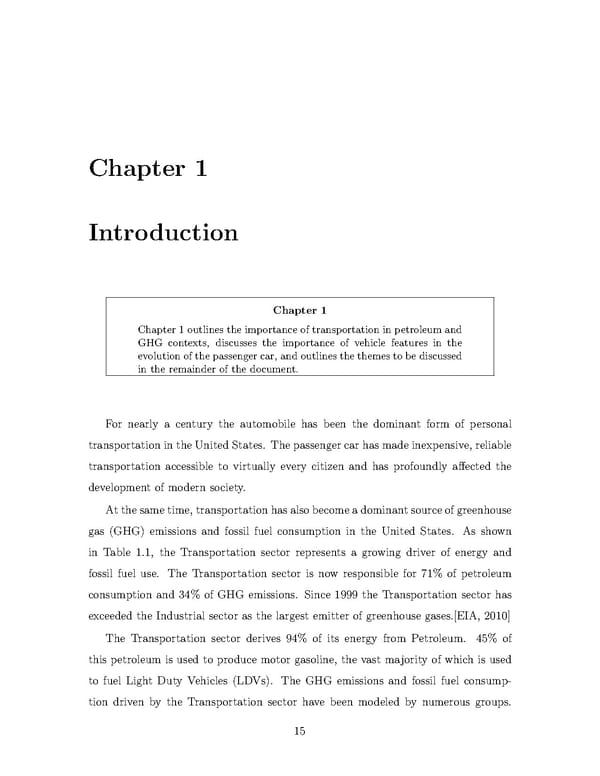
Table 1.1: Data from EIA showing historical energy consumption and GHG emissions by sector. The fundamental factors driving such consumptions are shown below, adapter from [MIT, 2008]. GHGemissions=LPK⇤VKT⇤FI Where, GHGemissions=GreenhouseGasEmissions(tons/year) LPK=LitersperKilometer(L/100km) VKT=Vehicle Kilometers Traveled (VKT in km/year) FI=GHGintensity of Fuel (GHG tons/liter of fuel) 16
While there are interactions among these factors, LPK is the only factor here reliant on the technical sophistication of vehicles themselves while FI and LPK are primarily a product of infrastructure and usage. 1.1 Vehicle Evolution During its development over the past century the passenger car has evolved from a rudimentary, self-propelled ”horseless carriage” to a sophisticated device capable of traveling hundreds of miles at high speeds. All new vehicles sold in the United States incorporate seat belts and at least two airbags; virtually all new vehicles include air conditioning and automatic transmissions to increase driver comfort and many also include navigation systems, moonroofs, and a bevy of other electronic aids. Gains in performance, size and fuel economy are relatively straightforward to analyze, as these factors have been carefully tracked since 1975 in the EPA Fuel Economy trends report. As shown in Figure 1-1 below fuel economy grew rapidly from approximately 1977-1987 and has since remained relatively constant. Vehicle performance has continually increased since the mid-1980s and vehicle size, measured using interior volume, has also grown modestly over the same time period. However, vehicle capability has improved in other ways as well. Vehicles are safer, emit fewer criteria pollutants per mile traveled, and include a broad array of equipment designed to improve dynamic capabilities provide the driver with a high level of comfort and information. [Cheah, 2010] highlights the importance of vehicle features by comparing two ve- hicles: a 2008 Audi A4 and a 2006 Mazda3 Touring, as shown in Table 1.2. The two vehicles are nearly identical in performance, interior space, exterior dimensions and highway fuel economy. However, the Audi has a significantly longer list of standard equipment, performs better in several crash tests, is 50% more expensive and weighs 345 kg more than the Mazda. Cheah attributes the mass increase primarily to the higher feature content of the Audi. However, this is only a single data point: a closer examination is needed to address the fleet-wide impact of features on the mass of 17
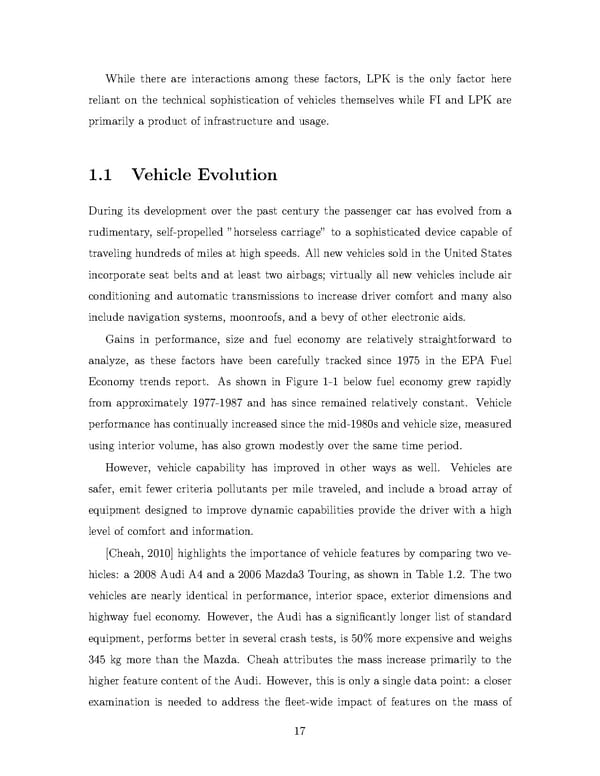
Figure 1-1: Average performance, size and fuel economy of new U.S. cars, 1977-2008, indexed to 1977 averages. Graphic from MacKenzie, 2009 using data from U.S. EPA, 2008 vehicles. Figure 1-2 graphically illustrates four case studies of growth in the mass of vehicles of various classes. 1.2 Motivation Existing work by [An and DeCicco, 2007, MacKenzie, 2009, Knittel, 2009] has in- vestigated the tradeo↵s among performance, size and fuel economy and consumer willingness to pay for said attributes. However, as shown by Cheah in the previous section, vehicles similar in these common metrics may still be substantially di↵er- ent in their ability to deliver functionality to the purchaser in the form of additional features. The need to quantify this tradeo↵ dimension has, to date, remained unfilled. Performing an analysis of vehicle features pays dividends in other ways. While features such as fuel injection, multiple valves per cylinder and variable valve timing 18
Table 1.2: Audi A4 vs. Mazda3: A comparison of vehicles with similar primary attributes but very di↵erent features. Adapted from [Cheah, 2010]. Year, Model 2008 Audi A4 2.0T Quattro 2006 Mazda3 s Touring Body style 4-dr sedan (seats 5) 4-dr sedan (seats 5) Wheelbase 104.3 in 103.9 in 3 3 length x width x height 180.6 x 69.8 x 56.2 in 178.7 x 69.1 x 57.7 in 3 3 Overall volume (l*w*h) 11.61 m 11.68 m Horsepower 200 hp 160 hp Power-to-weight ratio 0.057 hp/lb 0.058 hp/lb 0-60mph (est.) 9.58 sec 9.59 sec Engine displacement 2.0L I4 2.3L I4 Front head, leg room 37.9 in, 41.3 in 39.1 in, 41.9 in 3 3 Luggage capacity 13.4 ft 11.4ft City/hwy(adj.) fuel econ- 22/31 MPG 26/32 MPG omy Features 16“ wheels, AWD, power seat ad- 17“ wheels, FWD, manual justment, sunroof, heated mirrors, seat adjustment, sunroof op- dualzoneclimatecontrols, 10speak- tional ers + subwoofer, traction and stabil- ity control NHTSAcrash test ratings 4, 4, 5, 4, 4 stars 4, 4, 3, 3, 4 stars driver, passenger, side im- pact front, rear, rollover MSRP $28,900 $17,600 Curb weight 1,595 kg (3,516 lb) 1,251 kg (2,758 lb) (VVT) are tracked by the U.S. EPA, the deployment rates of these features are not strictly the product of consumer demand and automaker ability to deploy such technology. To varying degrees each of these technologies has been driven by criteria pollutant regulations. Because of this, viewing the deployment of such features in the broader context of safety regulation-driven and optional features serves to better characterize deployment of technology in the automotive fleet. 1.3 Research Objectives Thisthesis serves to address the following primary research questions described below. Mass Impact What has been the impact of safety and emissions requirements and 19
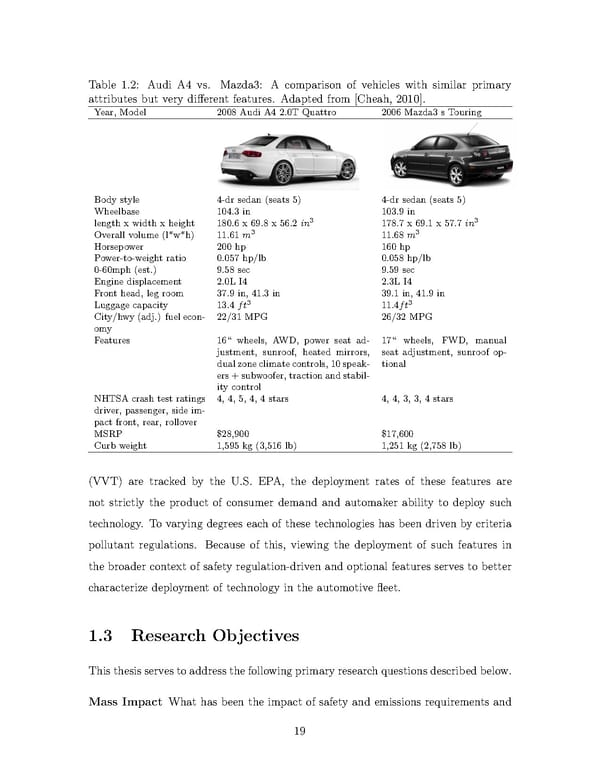
Figure 1-2: Growth in mass of vehicles from four major classes from [Glennan, 2007] other optional features on the mass of automobiles in the United States? Trends in Features What is the trend in deployment of features in each of these areas? Technical Sophistication How can information about vehicle features be used to refine existing measures of technical sophistication? Deployment Scenarios What do past trends in feature deployment rates tell us about possible future deployment of vehicle features? 20
